
Zebra Mussel Information and Updates
Riding Mountain National Park
Zebra Mussel Response 2025
In fall 2024, Parks Canada staff found hundreds of live juvenile zebra mussels attached to docks and infrastructure near the east end of Clear Lake. This indicated that zebra mussels are not isolated to the Boat Cove area of the lake, where they had previously been found and where the containment curtain had been installed. With input and advice from Indigenous advisors, the Province of Manitoba, and leading scientific and international experts, Parks Canada has determined that eradicating zebra mussels from Clear Lake in Riding Mountain National Park is not feasible.
Parks Canada will monitor infrastructure throughout Clear Lake and assess management options during the establishment of the zebra mussels. There are no immediate concerns about the implications for water treatment infrastructure. Parks Canada staff will continue to monitor the infrastructure and water quality, as well as provide potable water into the future.
Going forward, the AIS Prevention Program at Riding Mountain National Park should reduce the risk of spreading zebra mussels from Clear Lake to outlying water bodies and reduce the risk of introducing new invasive species (black algae, spiny water flea, rusty crayfish, etc.). In 2025, Parks Canada plans to permit watercraft on Clear Lake under a "one boat, one lake" aquatic invasive species prevention program. This program will be similar to the one implemented in 2023. The public will be invited to provide input on how the 2025 program will be applied.
What are Zebra Mussels?
Zebra mussels (Dreissena polymorpha) are native to eastern Europe. They were first detected in North America in the Great Lakes in the mid-1980s. Since then, they have infested many waterbodies in eastern North America. They were first detected in Manitoba in 2013 when they were discovered in the south basin of Lake Winnipeg. They later also colonized the Red River from the US border to Lake Winnipeg. Since then, they have invaded the Nelson River from Lake Winnipeg to Hudson Bay, as well as Cedar Lake and Lake Manitoba.
Biology
Zebra mussels are freshwater hinged mollusks. They are filter feeders that attach themselves to solid surfaces. They breed very quickly, as females can release up to one million eggs each breeding season. After the eggs are fertilized, larvae (called veligers) emerge and are free-floating for up to a month. The larvae are microscopic and do not swim. Veligers float through lake and river currents until they settle on a solid surface. This natural dispersal method means they can easily affect waterways downstream from an invaded area. Zebra mussels have few, if any, natural predators in North America. As a result, they often permanently alter the food web and ecosystems they invade.
Negative impacts on people include:
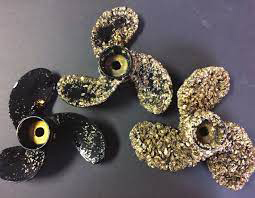
- Increased maintenance costs
- Damage to equipment such as boats, hydro-electric generating facilities, water intakes, and other infrastructure along infested water bodies
- Injury from sharp shells
- Potential negative health impacts resulting from increased likelihood of toxic algae blooms
Negative impacts on aquatic ecosystems:
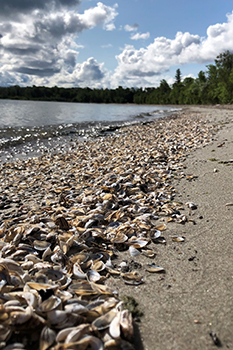
- Altering the food web by out-competing native species, like native mussels and other small invertebrates, for food (plankton)
- Removing large amounts of non-toxic algae (plankton) from the water and leaving behind toxic algae (cyanobacteria) to thrive, causing toxic algae blooms
- Affecting fish spawning areas by changing the surfaces of rocks and vegetation, impacting the survival of fish eggs
- Creating clearer water, allowing sunlight to penetrate deeper and changing the habitat by increasing the growth of submerged aquatic vegetation
Zebra mussels are especially harmful to native mussels, many of which are species at risk. They outcompete these species for food and will attach themselves to native mussels, suffocating them.
An infestation of zebra mussels in Clear Lake presents a real threat of significant and irreversible damage to the lake and downstream waterbodies.
2024 Aquatic Invasive Species Monitoring and Sampling Summary Clear Lake
eDNA Sampling
What is eDNA? Environmental DNA at Parks Canada - Nature and science
Technique: DNA is the genetic material found in all living things. DNA is released into the environment by organisms in the form of feces, mucus, skin cells, hair, etc. This is known as environmental DNA (eDNA). Scientists can collect samples from the environment to determine if the DNA of a particular species is present in that area. Water samples are collected from lakes in Riding Mountain National Park to test for eDNA from zebra mussels.
Results: On May 22, 2024, eDNA sampling began on Clear Lake with a plan to continue until the lake froze over in mid-November. Sampling sites were chosen from pre-existing high priority locations and select sites from the 2024 Clear Lake eDNA winter monitoring.
A total of 86 out of 552 water samples taken from Clear Lake tested positive for zebra mussel (Dreissenid) eDNA in 2024. Zebra mussel eDNA has been observed widely in Clear Lake with 56 out of 86 (65%) positive samples coming from the Boat Cove and the Main Beach Pier areas (Figure 1).
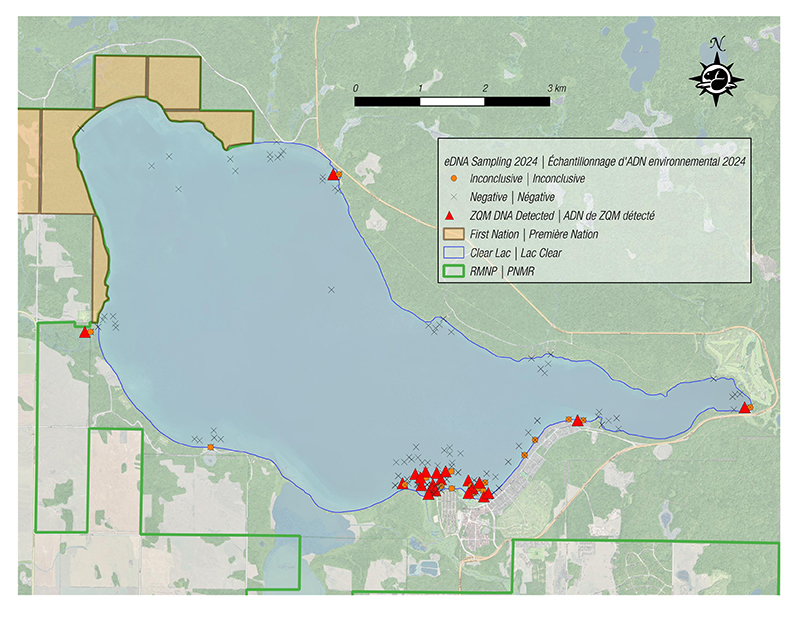
The first positive samples were observed on June 19-20, when water temperatures reached 13 to 15°C at Boat Cove. In July, eight additional positive eDNA samples were collected at distances of up to 300 meters from Boat Cove's shoreline. Parks Canada received positive eDNA samples from the Boat Cove, the east end of Clear Lake, and spruces day use area continually into late August. Positive eDNA samples were found in the east end of Clear Lake into November.
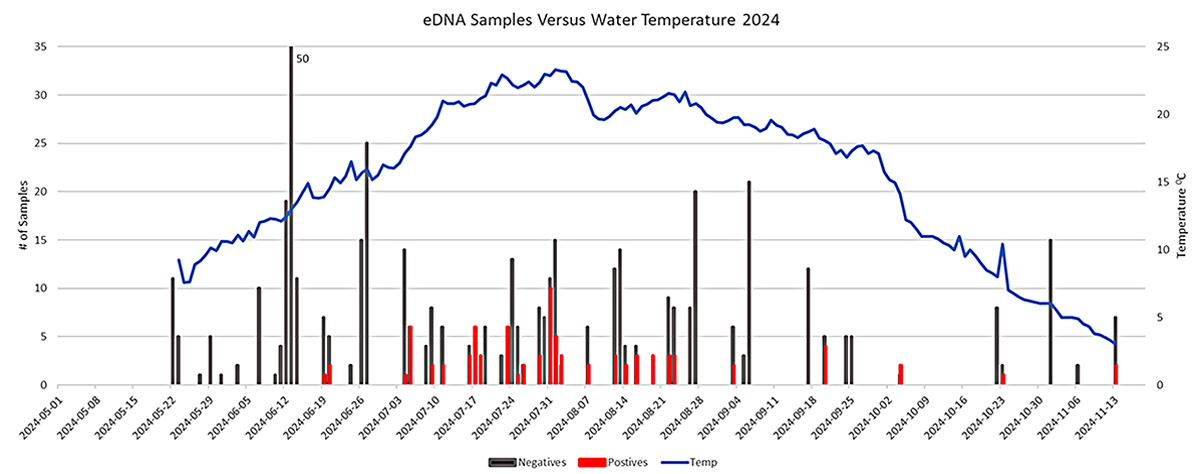
Visual searches
Technique: Parks Canada staff and partners visually searched for evidence of zebra mussels by snorkeling, diving, and monitoring shorelines and infrastructure in Clear Lake with the use of a remotely operated underwater vehicle equipped with a camera.
Results: Fisheries and Oceans Canada divers searched for zebra mussels in Clear Lake on June 3- 4, 2024. No zebra mussels were found near the Main Beach Pier, the Martese tour boat, or the greater area surrounding the Main Beach Pier.
Parks Canada snorkellers searched again from July 17- 22. On July 17, one live adult zebra mussel and one partial zebra mussel shell (dead) were found approximately 40m east of Boat Cove. No other zebra mussels were found near the Main Beach Pier, the Martese tour boat, or elsewhere in the Boat Cove area. Snorkellers conducted a visual search of the water near Spruces day-use area following a positive eDNA test, with no further evidence of zebra mussels found.
On September 19, 20, 26, 27 and October 7 and 11, 2024 Parks Canada staff inspected and removed docks from Clear Lake with zebra mussels attached. Juvenile zebra mussels ranging in size from 2mm to 7mm were found attached to 14 of 26 docks. The settlement of juveniles on docks was assumed to be confined to the east end of Clear Lake based on 2024 observations (prevailing winds and associated current movements). An additional four docks from outlying lakes were inspected with no observed presence of zebra mussels.
A contracted dive team searched water-intake infrastructure, the Main Beach Pier structure and docks, the Martese tour boat, the shoreline in front of Boat Cove, and the old campground from September 24 to 26. There was no evidence of zebra mussels found.
On October 9, Parks Canada snorkellers inspected the Clear Lake Golf Course water intake system in the east end of the lake. There was no evidence of zebra mussels found.
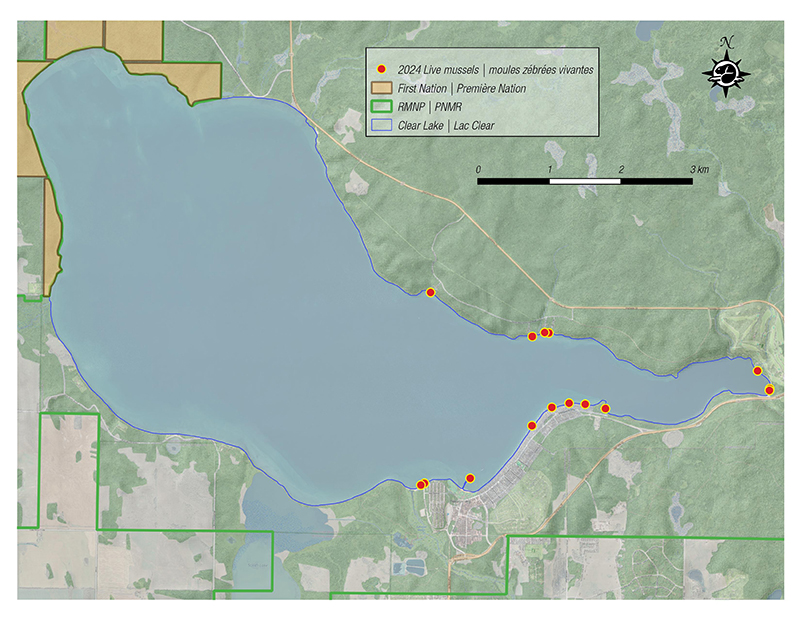
Substrate samplers
Technique: A piece of hard material, suitable for the colonization of zebra mussels, is submerged underwater for a predetermined amount of time. This sampling method indicates whether zebra mussels are able to successfully reproduce and establish in the area. The sampler normally remains underwater for an entire season before being assessed for tiny zebra mussels growing on the plastic.
Results: A total of 11 substrate samplers were placed in high priority areas in Clear Lake in early June and retrieved on October 4th. Samplers were outfitted with temperature sensors to gather seasonal water temperatures. Two juvenile zebra mussels were found on one substrate sampler located near the dock at the east end of the lake. Zebra mussels were not found attached to any other substrate samplers.
Plankton Tows (Veliger detection)
Technique: Plankton tow sampling is a form of early-detection monitoring for zebra mussel veligers (larval life stage). A fine mesh net is pulled through the water and the collection is analyzed under a microscope. This method can also identify other microscopic aquatic invasive species such as spiny water flea.
Results: From June 19 to September 30, 2024, 95 plankton samples were collected from Clear Lake. There was no evidence of zebra mussels or spiny water fleas.
Next Steps
The online questionnaire is now closed. Thank you for your input.
The input collected along with feedback received from stakeholders, community members and visitors over the last year will be used to develop a “What we Heard” document. This information will be taken into consideration and used to inform the management decisions that will be made in early April 2025.
Aquatic Invasive Species Prevention Program Timeline of Events
Summer 2011 – Monitoring for AIS, specifically zebra mussels, in Clear Lake begins.
Summer 2015 – Mandatory Parks Canada AIS inspections and decontaminations begin at Riding Mountain National Park.
Summer 2011 to 2023 – Water samples from Clear Lake and surrounding water bodies are taken and tested for zebra mussel eDNA.
January 2023 – Parks Canada is informed by Fisheries and Oceans Canada of a positive test result for zebra mussel eDNA in a water sample taken at an area known as Boat Cove, in Clear Lake on August 4, 2022.
May 4, 2023 – Parks Canada announces that trailered watercraft intended for use on Clear Lake must not have been in any other waterbody in 2023 and must undergo an inspection by June 15. Boats that met the requirements had a tag installed that sealed the boat to the trailer. This tag ensured that the watercraft had not been in another waterbody and posed no risk of bringing in aquatic invasive species. If this tag was removed or tampered with, the boat would not be allowed to launch in Clear Lake for the remainer of the 2023 season. All human-propelled vessels (canoes, kayaks, stand-up paddle boards) were required to undergo a Parks Canada AIS inspection, and if needed, decontamination before launching in park waters.
November 10, 2023 – Parks Canada officials do a physical search at Boat Cove and a clump of 48 live zebra mussels was found and removed from the water. Before that, zebra mussels had never been found in Riding Mountain National Park.
May 2024 – Parks Canada implements watercraft management measures that restricted all recreational watercraft use on Clear Lake for the time required to determine if a population of zebra mussels had been established and for any potential remediation. With exceptions for emergency vessels, the commercial tour boat The Martese, and one vessel from the Keeseekoowenin Ojibway First Nation.
August 2024 – Parks Canada closes the Boat Cove for the construction and installation of an impermeable containment curtain in Clear Lake. The curtain was installed in an area of the lake where living zebra mussels were found in November 2023 and July 2024. Shortly after installation, the curtain was damaged and was no longer an effective means of containment and would be removed. The curtain could not be repaired or replaced.
September 2024 - Parks Canada found hundreds of living juvenile zebra mussels attached to docks and infrastructure near the east end of Clear Lake.
October to December 2024 - Extensive internal and external review of the evidence and data collected from Clear Lake in 2024.
Important links
Information Bulletin - Watercraft Management Measures for Clear Lake in 2025
Prohibited activity - Pleasure Craft use in Riding Mountain National Park
Public Notice - Collection of information for watercraft permits
Aquatic Invasive Species Prevention Program
Clear Lake - Riding Mountain National Park
Questions and Answers
What are the current rules around boating on Clear Lake in Riding Mountain National Park?
With the exception of 2024, recreational motorized boating has been permitted via Superintendent’s Order on Clear Lake for many years. Non-motorized boating is permitted on all waterbodies in Riding Mountain National Park. All watercrafts must undergo and pass a Parks Canada AIS inspection prior to launching.
Historically, only electric motors, four-stroke engines, and direct fuel injection two-stroke engines have been permitted on Clear Lake, along with human and wind-powered watercraft.
Will watercraft be permitted on Clear Lake in 2025?
In 2025, Parks Canada plans to allow watercraft on Clear Lake under a "one boat, one lake" aquatic invasive species prevention program. The program, similar to the one in 2023, would likely involve a tagging system to ensure that vessels have not been in other water bodies and do not pose a risk of introducing new aquatic invasive species into Clear Lake.
How will the 2025 program be implemented?
When will a final decision be made on how the watercraft management measures will be applied in 2025?
Parks Canada is seeking input from stakeholders, visitors, and community members to determine the best long-term approach for the "one-boat, one-lake" program. This input will be considered in management decisions to ensure the program reflects the values of all parties involved.
Details about the prevention program for Clear Lake in 2025 will be widely communicated before season opening (May Long Weekend).
Is a “one boat, one lake” prevention program considered a best practice for addressing aquatic invasive species?
The key principle behind “one boat, one lake” is that it minimizes the movement of invasive species from lake to lake. Aquatic invasive species can be transported through water on boats, trailers, or even in mud on the equipment. If people are committed to using their boats only on one water body, it reduces the risk of transporting invasive species.
As part of broader aquatic invasive species prevention efforts, this program also stresses the importance of boat inspections and following Clean, Drain, Dry principles. This includes draining all water, removing mud and vegetation, and drying the watercraft and all related equipment thoroughly between launches.
Will stakeholders, community members and members of the public have an opportunity to provide feedback?
Parks Canada representatives will be set-up near the skating rink behind the Visitor Centre on February 1 and 2 from 12:00 PM to 4:00 PM. The information collected will be used to inform the management of Clear Lake’s aquatic invasive species prevention program for 2025. There is also an opportunity to provide input through an online questionnaire available until February 28, 2025 through this link: https://parks-parcs.simplesurvey.com/f/s/Clear-Lake-Riding-Mountain-2024
Why has Parks Canada decided not to pursue eradication of zebra mussels in Clear Lake?
A review of data in the fall of 2024, with input from Indigenous advisors, the Province of Manitoba, and leading scientific and international experts determined that eradication of zebra mussels from Clear Lake is no longer an achievable option.
Eradication requires that the full population be identified, fully isolated and contained from the rest of the lake. There was significant time and effort spent trying to find a population cluster, as well as preparing for eradication attempts if such a population was found.
Although an attempt was made to isolate an area of the lake were eDNA had indicated the presence of a potential colony, additional data gathered in 2024 demonstrated that zebra mussels are much more spread out in the lake than initially thought, and the full extent of the zebra population is not yet known. Parks Canada has taken action based on the best data available at any given moment since the first discovery of zebra mussel eDNA in the lake.
Did the malfunction of the containment curtain play a role in the decision not to attempt eradication?
At the end of the boating season, zebra mussels were detected at numerous, widespread locations in the east end of the lake. Based on size, growth rates and numbers found, establishment likely occurred earlier in the summer, before the curtain was installed. Even if the curtain had held up, zebra mussels would not have been fully contained and eradication would not have been successful.
The containment attempt was based on the best available information and was initiated in the area with the highest potential for zebra mussel establishment. The failure of the curtain was something that demonstrated the limits to using this approach to isolate sections of large, open bodies of water.
Understanding why high rates of eDNA were detected in Boat Cove and lower rates of eDNA were detected where other living populations of zebra mussels have since been found requires further analysis.
What will happen to Clear Lake going forward?
Over time, zebra mussels are likely to spread throughout Clear Lake and downstream. Although veligers cannot actively “swim”, they will be spread by natural currents (e.g. thermal cycling, wind driven, and gravity). Zebra mussels are likely to negatively impact the existing ecology of Clear Lake by altering food chains, water quality and aquatic habitats. There may be a greater risk for toxic blue-green algae blooms which pose increased risks to visitor safety.
What does this mean for communities downstream?
Zebra mussel veligers float through lake and river currents until they settle on a solid surface. Although they are likely to spread downstream through the outlet of Clear Lake, via Wasamin Creek (Clear Creek), down through the Little Saskatchewan and Assiniboine River Systems, it is currently unknown exactly how far they may travel and whether they will reach suitable habitat to settle and reproduce.
Will zebra mussel research and monitoring continue in Riding Mountain National Park?
Aquatic invasive species monitoring will continue and will be focused on the spread of zebra mussels throughout the western portion of Clear Lake. There will be an increase in monitoring and sampling at outlying lakes such as Moon Lake, Grayling Lake, Whirlpool Lake, Lake Katherine, Lake Audy, and Deep Lake. Ensuring that zebra mussels are not spread to other lakes in the surrounding area will be considered imperative.
How will Parks Canada manage the impacts of the zebra mussel invasion in Clear Lake?
Parks Canada will monitor infrastructure throughout Clear Lake and assess management options while evaluating the establishment of the zebra mussels. There are no immediate concerns about the implications for water treatment infrastructure. Park staff will monitor this infrastructure and water quality and will continue to provide potable water into the future.
What plans does Parks Canada have if zebra mussel eDNA is detected in an outlying body of water ie. Moon Lake?
For more information contact: comms-riding@pc.gc.ca
Information:
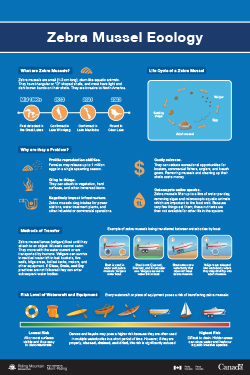
 579 KB
579 KB
- Date modified :